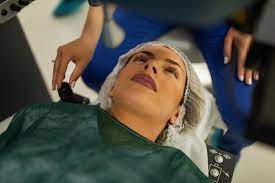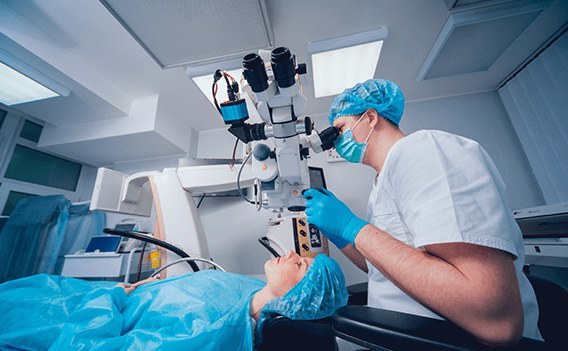One of the most common eye conditions, cataract is a collection of cloudy patches on your lens that disrupts the transmission of light to your retina. While there are different types of cataracts, the most common type is a clouded lens. Learning how a cataract test works can help you understand the process and potential complications.
The most common cause of cataracts is age. As the lens wears down, it becomes more likely that the protein and other debris will build up and create a cataract. Other factors that can contribute to cataracts include exposure to sunlight (including UV rays), and smoking.
Contents
What Is A Cataract Test?

A cataract test is a simple procedure that is used to check for and diagnose the presence of a cataract. A cataract is a clouding or opacification of the lens of the eye. The result can be vision impairment. There are two types of cataracts: primary and secondary. Primary cataracts are the most common type, and they develop as we age. They occur when the lens starts to become too cloudy from age, injury, or disease. Secondary cataracts are caused by other factors, such as diabetes, high blood pressure, smoking, and UV exposure.
A cataract test involves placing drops on either side of your eyes to create a contrast effect between light and darkness. The doctor then uses a device to measure how much light is being allowed into your eyes at each point in time. This allows them to determine if there is any damage to your lens from the clouding material inside it. If there is damage, it may be necessary for you to have surgery to remove the clouded lens and replace it with an artificial one.
When Should Be Tested For Cataracts?
When one develops a cataract, it is most common during the aging process. However, this isn’t the case for everyone. Some people with a family history of cataracts may be more likely to develop one or some who smoke or have an illness that puts them at higher risk may also need to contend with cataracts.
A cataract checklist must be included. These are as follows:
Cataract symptom checklist:
- Is your vision blurry or becoming cloudier than it used to be, even in bright light? Does your double vision continue for a long time after you have stopped?
- Do colors appear dimmer than they used to look? Have your lenses changed frequently in the past few years? If one of these statements is True, you may have a cataract.
- To know for sure and get the treatment that’s right for you, see an eye care professional as soon as possible.
If you answered yes to any of these questions, it may be time to have your eyes checked by an eye care professional.
What Happens During A Cataract Test?
Knowing whether you have a cataract can be tricky. But there are three eye tests, taken during a comprehensive eye exam, that your doctor can use to determine if this is the issue: a retinal exam, a slit-lamp exam.
Visual acuity test
If you’re ever asked to take a visual acuity test, your doctor will ask you to read different-sized letters from an eye chart, one eye at a time. By being able to read the letters, you may be able to determine if you have a vision impairment.
Retinal exam
A retinal exam will involve examining the back of your eye to see if your lens is being affected by a cataract. In order for your doctor to examine the retina, you’ll be given special prescription eye drops to dilate your pupils. Once your pupils are fully dilated, the doctor will look at your retina with a slit lamp or an ophthalmoscope.
Slit-lamp exam
A slit-lamp exam enables doctors to find abnormalities in your eyes, like cataracts. This is an examination that utilizes a strong beam of light in order to provide a clear, magnified view of the eye (including the iris and cornea) and your eyelids.
Why Cataract Test Is Important?
Cataracts are not all the same, and they often require different treatments to get the best outcome. If you’re experiencing signs of a cataract such as blurry vision or seeing halos around lights, it’s important to speak to an eye doctor about all your visual complaints before moving forward.
Vision problems are complicated, and sometimes it can be difficult to figure out what you might need. For example, if you’re having vision problems and believe you might have cataracts. It’s important to get a complete assessment before undergoing an examination by one of our doctors. Before your appointment with one of our doctors, you fill out a cataract questionnaire so that we know exactly what’s going on.
Types of Cataract Test

Cataracts are a common eye condition in which the normal lens of the eye becomes clouded over. This can cause vision problems and can lead to cataract surgery. There are several types of cataracts, but all share some common features.
A cataract is a buildup of protein and other materials in the lens of your eye. Over time, this can cause the lens to become cloudy and less effective at focusing light on your retina. Cataracts can develop in any age group, but they are most common in older people.
There are two main types of cataracts: nuclear and non-nuclear. A nuclear cataract is composed of individual cells that have lost their ability to fuse together properly. This type of cataract is usually more severe and causes more visual problems than a non-nuclear cataract. Non-nuclear cataracts are made up of deposits from the proteins that make up the lens’s surface. They don’t usually cause any symptoms, but they can also progress to a nuclear-type cataract over time.
Most cases of cataracts start with tiny growths on the surface of the lens called ascomata. As these growths grow, they create spaces between the cells in the lens (vacuoles). Over time, these vacuoles fill up with debris and proteins, making the lens cloudy and less effective at focusing light on your retina.
Benefits of a Cataract Test
A cataract is a clouding of the eye’s lens that can cause blurry vision. The most common type of cataract, which affects around one in every eight people over the age of 60, is a senile cataract. This occurs when the proteins that make up the lens start to break down and become clumps. A cataract test is a procedure used to determine if you have senile cataracts or other types of cataracts.
The test involves using an ultrasound machine to create images of your eye. These images will be examined by a doctor to see if there are any signs of senile cataracts. If there is, a surgery called an intraocular lens implant may be recommended. Otherwise, the doctor may suggest regular visits for checkups to monitor the progress of the cataract and eventual removal if necessary.
There are several potential benefits of having a cataract tested.
First, if you have senile cataracts, your doctor may be able to advise you on the best way to manage them. Second, testing can help to determine if you are at risk for developing other types of cataracts.
Finally, if you do have senile cataracts, testing may help to identify the best time to have the surgery and minimize any potential damage to your vision.
How the Cataract Test Works
The cataract test is a simple procedure that can help detect whether you have a progressive cataract.
During the cataract test, your doctor will shine a bright light into your eyes. If you have a progressive cataract, this light will cause the lens in your eye to become cloudy and eventually fall out. The cataract test is often used as one of the first steps in diagnosing and managing cataracts. There are two main types of cataracts: open-angle and closed-angle. Open-angle cataracts occur when the lens gets clouded from the inside out (from age, smoking, etc.). Closed-angle cataracts occur when the lens gets clouded from the outside in (from exposure to ultraviolet light or certain chemicals).
The process of developing a progressive cataract typically starts with small changes that gradually make it harder for the lens to work properly. These changes may include:
1) A decrease in the size or number of vision receptors in your eye’s retina (photoreceptors). This can happen because of aging or injury.
2) A decrease in the ability of the lens to flex or change its shape.
3) A gradual loss of transparency in the lens.
4) Formation of a hazel or brown “cloudy area” on the lens called a cataract nucleus.
If you have any of these changes, your doctor may recommend a cataract test.
The cataract test is performed by shining a bright light into your eyes. If you have a progressive cataract, this light will cause the lens in your eye to become cloudy and eventually fall out.
The cataract test is often used as one of the first steps in diagnosing and managing cataracts. There are two main types of cataracts: open-angle and closed-angle. Open-angle cataracts occur when the lens gets clouded from the inside out (from age, smoking, etc.). Closed-angle cataracts occur when the lens gets clouded from the outside in (from exposure to ultraviolet light or certain chemicals).
Risk
There are several potential risks associated with cataract testing.
- The most common is that the test may require the use of an ultrasound machine, which could cause discomfort or injury to your eye.
- Other risks include the possibility of visual impairment if the cataract is senile, and the risk of developing other health problems during or after the surgery.
Conclusion
A cataract is a type of eye disease that can cause vision problems. If you’re over the age of 40, your chances of developing a cataract are significantly higher than if you were younger. Cataracts can form from the proteins in the eye’s lens becoming cloudy and hard to see through. There are three main types of cataracts: nuclear, posterior, and intraocular. The process of testing for cataracts involves taking pictures of your eyes with different light levels so that an optometrist can determine which type you have. Once they have determined what type you have, they will prescribe a treatment plan based on that information.
Cataracts can be a serious eye disease, and if you experience vision problems, it’s important to get them checked out as soon as possible. The process of testing for cataracts is simple and painless, and if you have any questions about it, your optometrist will be happy to answer them.
At MantraCare we have a team of experienced eye surgeons, who will be happy to answer any questions on cataract surgery. Call us at +91-9711116605 for any inquiries.
